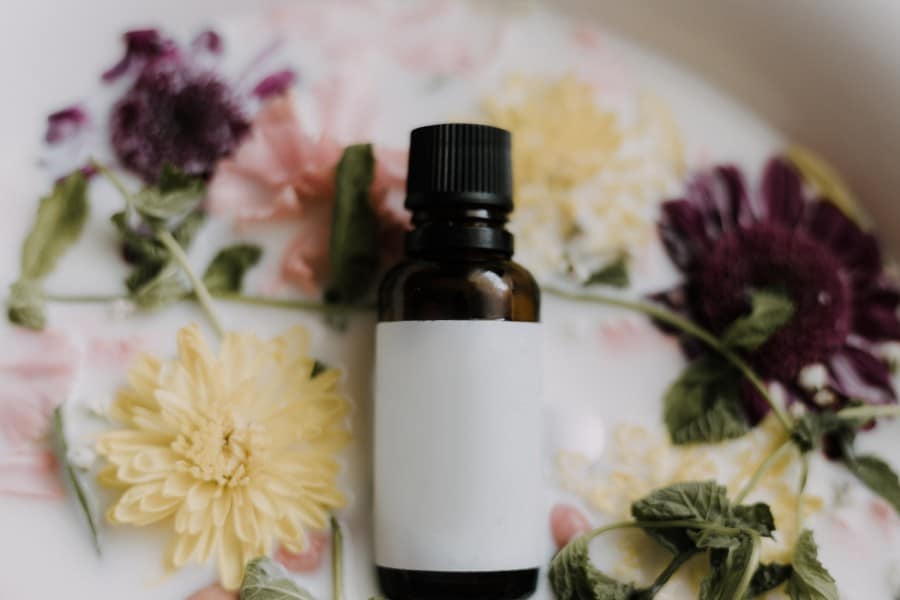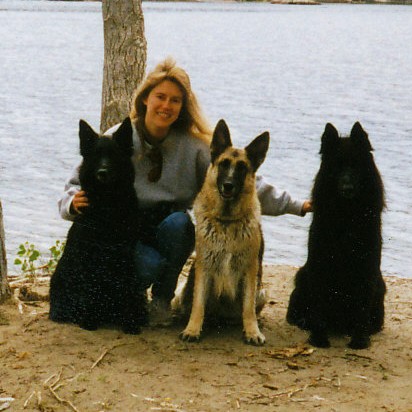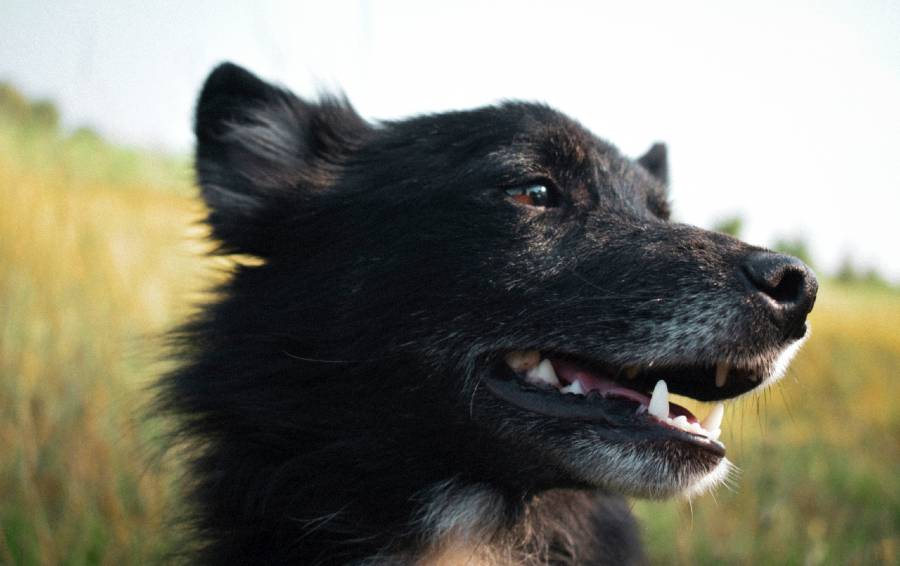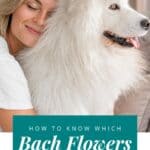Dog aggression, anxiety, reactivity – many common dog behavior problems respond beautifully to Bach flower remedies. But successful treatment depends on choosing the correct remedies for your dog’s emotional state. Learn how to select the best Bach flower essences for the emotions behind your dog’s behavior issues in this free guide.
“My dog goes ballistic when he sees other dogs. What flower remedy do I give him for that?â€
“Our two dogs are trying to kill each other. Is there a Bach flower for that?â€
“My dog has separation anxiety. He’s already destroyed two crates. Will Rescue Remedy stop the behavior?â€
So goes my email inbox on any given week.
The first thing to realize is : Flower remedies do not address problem dog behavior. Not directly. What they do is balance the emotions behind the behavior.
Which can be amazingly, mind-blowingly helpful. But it’s important to recognize that, when selecting Bach flower Remedies for dogs, there won’t always be an obvious choice for a particular behavior issue. It won’t necessarily be as simple as Behavior A = Flower Remedy B.
There is no one remedy for all leash reactivity, for instance. Or for dogs that fight. Or for separation anxiety. Or even for noise sensitivity.
Why is that? Because all those behaviors have an emotional basis, and the particular emotions in play in my dog may be different than in your dog, or your neighbor’s.
The key (and challenge) with Bach flowers is taking the time to discover what your dog is feeling. Once you work that out, it’s pretty straight-forward to select the appropriate flower remedies for the job.
Your Dog’s Body Language Reveals its Emotions
With very few exceptions, dogs tend to wear their emotions on their sleeve. That is, what you see in their body language is what they’re feeling. So, a very effective and reliable way to select Bach flower remedies for dogs is by observing body language.
Ask yourself, when my dog is doing the problem behavior, what emotions can I see on the surface?
Look at your dog’s facial expression. Look at the way he holds his head, ears, body, tail, etc. when he’s reacting in a way you’re concerned about.
Is his body language confident? Nervous or fearful? Is he puffed up like a jock at a frat party? Tentative and unsure? Or maybe there’s a mix of different signals.
Concentrate on what you can see; on the emotions that show themselves during the behavior that’s troubling you.
If the behavior happens too quickly for you to observe your dog carefully, or if you have trouble observing your dog while he’s acting that way (because he’s upsetting you, or you’re too busy trying to deal with him to step back and observe), then ask a friend to watch and report what they see. Or set up a video camera so you can get a better idea of what’s happening. (Video can be extremely valuable for analyzing and thinking through any dog behavior or training problem, not just for Bach flowers.)
Learning to read canine body language
If canine body language is a mystery to you, take the trouble to become educated in it. This will not only help with selecting flower remedies, it will help you work more effectively with your dog, and by helping you understand your dog better, will likely improve your relationship altogether.
Here are some resources that may help:
1) Stanley Coren’s article: How To Read Your Dog’s Body Language is a good place to start your learning.
2) If you’d like a deep dive, this great webinar series on Canine Communication & Behavior is available for free via the ASPCA Pro website.
3) There are probably hundreds of videos of varying usefulness on canine body language. I thought this was a good one on how dogs show fear, avoidance, aggression, and similar emotions:
Alternative Ways to Select Bach flowers
Besides the primary method of simply observing your dog, there are other methods people use to select flower essences for animals. Some of these methods stem from the popular sense that somehow, flower remedies are “New Age†or “mysticâ€. So, it’s not unusual to see references to selecting flower remedies through psychic readings, pendulums, intuition, and applied kinesiology (also known as muscle testing).
Personally, I don’t see any reason to believe that the way flower remedies work is “mystical†at all. Science has demonstrated that living bodies react to low level energy frequencies. The idea that we might react to very low level, “subtle†energies doesn’t seem far-fetched or un-scientific to me.
So, my first choice for selecting flower remedies will always be observational. I admit that, at times, I do rely on “gut feeling†when selecting flower remedies for particular dogs, but that feeling (i.e. intuition) is borne of decades of canine behavior work, and so realistically is probably 99% experience. If you have reliable intuition for what animals are feeling, then by all means use that. But I’d lean toward using it as a supplement to direct observation of behavior and body language, not as a substitute.
How did Dr. Bach recommend flower remedies be chosen?
Edward Bach’s focus was helping people with his remedies, not animals. Some were people with physical illness; others had with emotional struggles. Many were everyday, average people who experienced emotional blockages that impacted their happiness, goals, or stamina.
We will have to adjust his words slightly for animal use. But honestly, not a lot.
Here is what he said about it:
- The method of selecting flower remedies is simple enough for most people to understand.
- There is no scientific knowledge required when treating with them.
- We simply take notice of the individual to be treated: how their emotions, moods, and reactions are affected.
- A little knowledge, empathy, and basic understanding of behavior – which is present in almost all of us – is all that’s needed.
I have to say, it’s very similar with dogs and other animals.
To boil it down:
- Have some empathy.
- Pay attention to the dog in front of you.
- Use common sense.
- Apply basic knowledge of canine behavior.
And maybe most of all?
Don’t overthink it. Avoid going deep and trying to psychoanalyze your dog. Treat the emotions that are right there on the surface.

Most Problem Dog Behaviors Represent a Mix of Emotions
In general, don’t expect your dog’s behavior to have only one emotional component. It can happen that there is one powerful, overshadowing emotional blockage that, once removed, the dog’s behavior resolves. If so, awesome.
But frequently, possibly most of the time, problem behaviors are more complex than that.
One dog’s leash lunging may be triggered by excitement, frustration, and poor impulse control. Another’s may be combination of anxiety, bossiness, and a desire to keep things around him in order.
One dog’s separation anxiety might stem from a scary event that has left him panicked about being left home alone. Another may have a lack of confidence complicated by over-attachment. Yet another might be frustrated and agitated by poorly introduced (or excessive) confinement.
Selecting the right Bach flower remedies is like selecting the right training approach: understanding the different factors motivating the problem behavior can make all the difference.
When your dog’s emotions are hard to define or narrow down
If your dog has many issues, or a confusing mix of them, prioritize as best you can. Sometimes there’s no real priority; it’s just a matter of making a decision as to what to address first. And that’s okay!
Don’t be surprised if you need to experiment a bit to find the right combination of remedies to help your dog. Fortunately, choosing the wrong essence will have no harmful effects – it will simply have no effect at all. And while that might be frustrating, think of it as being able to cross one possibility off your list.
Bach Flower Remedies for Dogs, Grouped by Type of Emotion
The following list groups the Bach flower remedies by type of emotion in dogs. I’ve tried to be brief and to-the-point in the individual descriptions.
Bach flowers for fear, anxiety and panic
Aspen restores a sense of security and calmness in skittish, edgy dogs that act as if something’s out to get them. Aspen addresses general apprehension rather than fear of particular, identifiable things.
Mimulus is for dogs that have specific, isolated fears or are timid by nature. Mimulus improves both confidence and courage, and helps dogs face their fears.
Rock Rose alleviates the “fight, flee, or freeze†response typical of panic and terror. It restores steadfast courage. We tend to think of those emotions in terms of big, dramatic displays of behavior, and they can be. But they can also show in a more restrained way. The more well trained a dog is, and the more self-control he’s learned, the more likely that panic will show in more subtle ways.
Red Chestnut addresses fear for and over-protectiveness of others. Typically, this over-concern is more likely to be directed at the young, small, ill, the physically weak, or emotionally needy or fragile. Red Chestnut helps restore a realistic confidence in the capabilities of loved ones.
Bach flowers for self-doubt and uncertainty
Centaury restores appropriate levels of assertiveness in dogs that are so willing and eager that they seem to have no will of their own. These are dogs that may work till they drop, or at least beyond what’s healthy either physically or emotionally.
Larch improves confidence and restores willingness to try in hesitant dogs that expect to fail. Larch is an excellent remedy for any dog that has lost confidence through mishap or punishment, so that they now anticipate failure and won’t even try.
Scleranthus levels out mood swings in dogs that shift back and forth between emotional extremes. It’s particularly helpful for behavior that cycles in patterns (due to such things as hormonal cycles, season cycles, moon phases, times of day, etc.). Scleranthus can also be useful to alleviate balance-associated problems like motion sickness.
Bach flowers for agitation
Crab Apple remedies the feeling of being unclean (or shame, in people); it restores a sense of self-worth and dignity. Dogs that have infestations of parasites may benefit from Crab Apple, in addition to physical treatments. Dogs that suffer emotionally when they have an accident, or become incontinent in illness or old age, may benefit from this remedy.
Impatiens is an extremely useful Bach flower remedy for tense, impatient, excitable, easily frustrated dogs. Impatiens helps dogs be more patient, less tense, and improves ability to handle frustration.
Vervain is for dogs that approach life as having a job to do. If you don’t provide one, they’ll choose something to be responsible for. These are usually highly intelligent breeds that analyze situations and try to be helpful. (Not always in ways we would like, however!) Vervain helps when these working-minded dogs get over-zealous, overly serious, or just too intense (or inappropriately intense) about getting the job done. Vervain restores appropriate levels of intensity, enthusiasm, and drive.
White Chestnut is for mental preoccupation and obsessing, and can be helpful with dogs with repetitive, obsessive behaviors, and dogs that fixate on an idea. This Bach flower remedy quiets the mind and restores clarity of thought.

Bach flowers for relationship issues
This includes controlling, manipulative behavior, attention-seeking, over-concern with status or with the behavior of others.
Chicory is for dogs that become controlling, manipulative, or possessive about relationships. It can show as quite a range of behaviors: guarding, acting out to get attention, possessive behavior with loved ones, inserting themselves in between one person and another to prevent or draw the person away giving attention or affection to another person or animal. Chicory helps “loosen the apron stringsâ€, restoring a healthier level and quality of attachment. (Note: this type of attachment is often reciprocal, in which case both the dog and their person should take Chicory, ideally.)
Heather is the flower remedy for the dog focused entirely on itself, and on making sure everyone’s attention stays on them. Heather increases empathy and restores the ability to be engaged but in a less self-centered way.
Rock Water restores a gentler, more flexible, less domineering attitude in dogs with emotional (and often accompanying physical) rigidity. Territorial dogs; dogs easily offended by “infractions†on their rules; dogs that insist on eating, walking, playing, sleeping at certain times and in certain ways; dogs that show stiff, hard posture when dealing with others; all can benefit from the softening effects of Rock Water.
Vine improves peaceful communication in dogs that resort to getting their way through shows of force and intimidation. Bullying behavior in dominant dogs can respond quite well to Vine flower remedy, but should, of course, be used in conjunction with thoughtful, non-confrontational training and behavior modification methods.
Bach flowers for over-sensitivity to influence
Agrimony is for the dog that strives to avoid conflict. Personal pain and conflicting emotions will be hidden behind a happy, cheerful face. Arguing and upset in the household also are very troubling to this dog. When in balance, this is a dog with a sense of humor, that delights in entertaining others. Agrimony restores a happy-go-lucky, optimistic attitude.
Cerato helps the dog that seems to have no ability to think or feel for itself. This dog changes behavior and attitude depending on the strongest personality present at the moment. This is a common trait in puppies, but generally can be expected to disappear as the dog matures. With dogs that retain this characteristic, Cerato helps restore individuality and a strong sense of self.
Walnut stabilizes emotionally vulnerable dogs during life changes and other times of strong outside influence. It acts as a sort of protective shell during transitions, and strengthens the ability to adapt to change while remaining true to the core personality.
Bach flowers for anger, irritability, and aggression
Beech increases tolerance and empathy in grumpy, testy, nit-picky dogs. Helpful to improve attitude in easily aggravated dogs, Beech also can help dogs that react poorly to changes in routine or environment.
Holly is the healer of heartfelt negative emotions: jealousy, hatred, suspicion, anger. Holly increases self-acceptance, and through this, improves willingness to accept of the idiosyncrasies of others.
Willow is for sulky, resentful, bad-tempered dogs. It restores equable temper in dogs that act out their resentment of the attention or favor given to others.
Bach flowers for sadness, discouragement, lack of interest or vitality, struggle
Elm improves emotional stamina and reduces overwhelm in overworked dogs, and dogs suffering burn out from long-term stress or illness.
Gentian improves perseverance in easily discouraged dogs. Excellent for dogs that won’t try anymore, that are resigned to failure or disappointment.
Gorse restores a hopeful, optimistic attitude in listless dogs that have lost their spark and vitality after an extended struggle or yet another setback.
Honeysuckle helps dogs to face the future with hopefulness and interest. This is an excellent remedy after loss of a loved one, as well as for homesick dogs, and dogs that pine for people, places, or activities that are gone or unattainable.
Hornbeam restores enthusiasm and eagerness in sluggish dogs that have a hard time getting started. In people, we’d call it that “Monday morning feeling”. This might be a temperament trait, or a temporary result of illness or injury.
Mustard relieves depression and restores a sense of light and serenity to depressed, downcast dogs that get down for no apparent reason. (Depression in dogs usually happens for a reason. A full medical checkup should always be done with dogs whose attitude changes significantly for the worse.)
Oak improves emotional stamina and endurance. Stoic, dutiful dogs that keep on keeping on, because they are made that way, can benefit from the restorative powers of Oak.
Olive renews and revitalizes dogs whose energy has been depleted due to illness, long-term emotional turmoil, extended show schedules, etc.
Pine relieves unwarranted feelings of guilt and self-reproach, and restores a healthy self-image. Do dogs experience from these emotions? It’s hard to say. I suspect they do, but in a different form than we humans do.
Star of Bethlehem relieves shock and disorientation from fright or trauma. It comforts and restores calmness in frightened, traumatized, or abused dogs.
Sweet Chestnut relieves despair in dogs that have reached their “wits’ endâ€. It improves emotional endurance in depleted dogs that experience extreme distress more easily than well-grounded dogs with emotionally supportive habits and lifestyles.
Water Violet restores warmth to aloof, introverted, distant dogs. It can help restore some level of sociability to dogs uninterested in casual social contact, but also helps dogs that withdraw socially when sick or in pain.
Wild Oat helps restore a sense of direction in dogs having to adjust to a new lifestyle or type of work. This can be a helpful remedy for retiring working dogs, show dogs, or performance dogs looking for a useful purpose to fulfill in their new lives.
Wild Rose is for dogs that have lost interest in, and joy of, life and living. Wild Rose restores spontaneity and vital interest. In older dogs, it can bring about an almost youthful pleasure in life again.
Conclusion
Bach flower therapy for dogs is pretty straight-forward – once you realize it’s the emotions behind the behavior that need to be targeted. When those emotions are brought into balance, problem dog behavior is far easier to work with, and sometimes goes away completely.
Taking a little time to learn what your dog’s body language is telling you about your dog’s emotional state will go a long way toward helping you select the best flower remedies.
If you’d like to learn more about what to expect when using Bach flower therapy for dogs, read my article, (cleverly titled), Flower Essences for Animals: What to Expect.
If you’d like more info on blending your own formula, my article Bach Flower Remedies for Dogs: Create Your Own Blend (Guide and FAQ) should help.
I hope you enjoyed this article. If you found it helpful, please share it with your friends!

Julie Cantrell BSc is a professional dog trainer and canine behavior consultant who’s logged many thousands of hours training dogs and teaching owners since 1990. Flower essences have been part of her work with canine behavior since 1994. (Bio)









